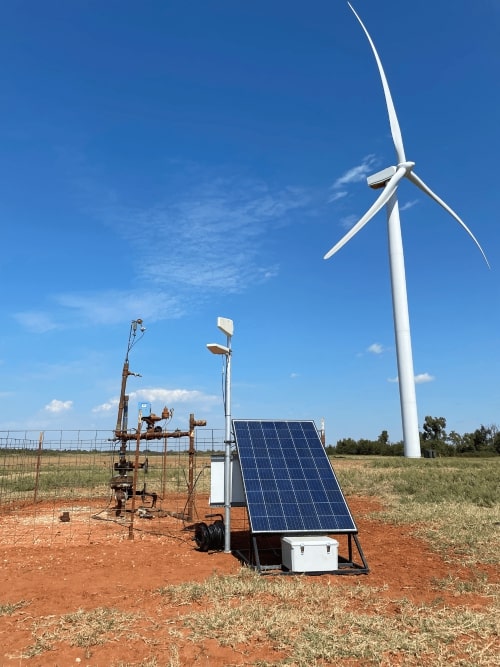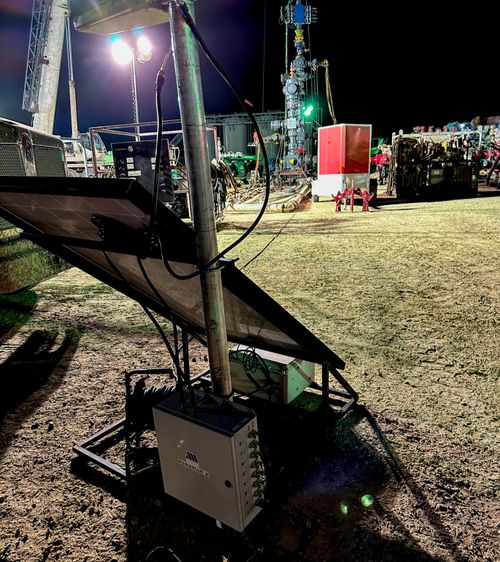
At a wellsite, the technology can help operators avoid costly fracture-driven interactions (FDI) — subsurface potholes that can damage the equipment, delaying production. (Source: Shutterstock)
Every sound that results from drilling for oil and gas is part of a seismic concert of information.
The full depth of the show hasn’t been accessible to humans — imagine a faint AM radio signal from a distant station. Now, with advances in sensors to detect the noise and artificial intelligence (AI) to interpret it in real time, the music is getting clearer, delivering information that can help save or make millions of dollars.

Momentum AI, a startup based in Oklahoma City, has built a software platform that does just that.
“Almost everything in the field downhole in production makes some kind of noise,” Scott Davenport, Momentum’s CTO, said in an interview with Hart Energy. “We can train a model to understand what the normal noise sounds like and filter out all the other noise and lifts for anomalies and report on those and tell exactly what they are.”
At a wellsite, the technology can help operators avoid costly fracture-driven interactions (FDI) — subsurface potholes that can damage the equipment, delaying production. Minimizing FDI magnitude can also help mitigate damage to parent wells, according to the company.
“The tech we’ve developed unlocks it automatically in real time, using neural networks to detect the FDIs,” said Reid Thompson, Momentum’s co-founder and COO. “If an FDI meets a certain criteria where we expect it to be a damaging frac hit, we can then send an alert and they can change the frac plan in real time.”
The advances come from better pressure sensors and faster analysis.
“On a regular pressure gauge, you’re sampling at one sample a second,” Thompson said. “What we do with 40,000 samples per second, we open up that entire frequency realm and shine light on it. It gives you information that isn’t being collected right now.”
Momentum’s other co-founders, brothers Jeff and Jon Rose, were acoustics and computing experts who helped the Department of Defense connect sound to specific munitions, said Todd Haller, company president. That work helped lead to Momentum’s platform.
“So we have something very profound and very rich when you think about the years that the code has been built,” Haller said. “It has deep neural networks built into the software, which in oil and gas is unheard of.”
The information comes from surface-level sensors that transfer information to the cloud, so there’s nothing that needs to be run down into a well. Setup can take less than an hour, and the rig gets power from solar panels, so no gas or electric hookup is needed.
“Once it's in the cloud, we run a multitude of different models to detect different things,” Thompson said. “One is to automatically detect the stages. Another is to predict pressure. And then the last one is to detect the frac hit.
“We'll have a sensor on each well head that goes into here, and we'll be on multiple pads at once, all sending that out from all those pads.”
Momentum has completed field trials with a major oil company, Thompson said.
“We've done six or seven different projects,” he said. “Basically, the product is now complete. We have additional projects that we're getting ready to be on. And then there are multiple companies that are interested in the technology.”
The primary product, FDai, has been the basis for three other products — BullsEye, a completion stage isolation tool assurance mechanism; FracScore, which measures completion design effectiveness; and FDai Insights, which analyzes previous frac jobs using AI.

Fdai’s saving on a four-well pad includes 7 hours of pumping, 7,000 gallons of diesel, 16,000 gallons of water and 6,500 gallons of flowback, according to the company’s website.
“Where we’re going to go midyear is SmartFrac,” Haller said. “It's basically laying AI on top of all of the data that's being collected so that the intervention is autonomous.”
The platform’s versatility lends itself to many other uses, Davenport said.
“We can jump into an adjacent market with a very large TAM [total addressable market], with very little capital investment,” he said. “The ideas are coming, we just have got to prioritize those and stay to our core and not get too thin. When we do something, we do it well and we get into these adjacent markets and we have a huge impact.”
Recommended Reading
E&P Highlights: Feb. 18, 2025
2025-02-18 - Here’s a roundup of the latest E&P headlines, from new activity in the Búzios field offshore Brazil to new production in the Mediterranean.
E&P Highlights: Feb. 24, 2025
2025-02-24 - Here’s a roundup of the latest E&P headlines, from a sale of assets in the Gulf of Mexico to new production in the Bohai Sea.
FLNG Gimi Receives First Gas from BP’s FPSO in the GTA Field
2025-01-22 - Golar LNG’s Gimi FLNG vessel will support BP, which began flowing gas from wells at the Greater Tortue Ahmeyim Phase 1 LNG project in early January.
E&P Highlights: Jan. 27, 2025
2025-01-27 - Here’s a roundup of the latest E&P headlines including new drilling in the eastern Mediterranean and new contracts in Australia.
E&P Highlights: March 17, 2025
2025-03-17 - Here’s a roundup of the latest E&P headlines, from Shell’s divestment to refocus its Nigeria strategy to a new sustainability designation for Exxon Mobil’s first FPSO off Guyana.
Comments
Add new comment
This conversation is moderated according to Hart Energy community rules. Please read the rules before joining the discussion. If you’re experiencing any technical problems, please contact our customer care team.




